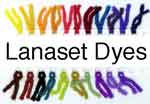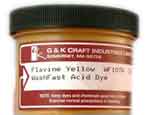What kind of dyeing is this called?
Hi Paula!

I am a beginner rug hooker and I am seeing all these gorgeous dyed pieces of wool. The one that intrigues me the most, I have attached a jpeg of and I'm hoping that you may be able tell me what kind of dying this is called? I'm sure once I know the correct term that I will be able to find instructions on your website?
Thanks!
Barb
That looks like low water immersion dyeing. My instructions for low water immersion (see "How to Do Low Water Immersion Dyeing") are for dyeing cotton and other cellulose fibers, and silk, using fiber reactive dyes, but you can use the exact same principle for wool dyes. The principle is to dissolve dye in a relatively small amount of water, and pour it over fabric which has been crammed into a small container.

(For silk, wool, angora,
mohair & nylon)
Buy from
Paradise Fibers
There are many different kinds of dyes that you can use to hand-dye wool. All are acid dyes. The best are the Lanaset dyes, which are very rich in color and which do not wash out even if laundered in hot water. The WashFast Acid dyes cost less than the Lanaset dyes and can be very satisfactory. Even Kool-aid and other sources of food coloring will work to dye wool, though the results are less wash-resistant.
You will need a dyeing pot to dye wool with any dye other than food coloring. Only food coloring is safe to use in the same cooking pots that you use for food, and then only if you are not using any mordants, such as are often used with natural dyes. Vinegar and citric acid are obviously food-safe. The pot should not be made of aluminum, which will react with the acids used along with the dyes. The best materials for a dyeing pot are stainless steel or enamel. In order to obtain a perfectly smooth, even solid color, you must use a large pot with plenty of space, with a lot of water, accompanied by a lot of stirring. For low water immersion, the requirements are the opposite: you do not need a large volume, and you do not need to stir. For small pieces of fabric, or small amounts of yarn, you can place the wool, dye, and auxiliary chemicals into quart-sized glass canning jars, then place these jars into a large cooking pot filled with water to the same height as the liquid inside the jars. The equipment sold to make canning easy, such as glass jar lifters, can be very handy to use.
Low water immersion dyeing is a trial-and-error process. If you find that you get too little color variegation, try again with less water, or a more tightly fitting container, or less stirring. If you find that you end up with too much white on some parts of the fabric or yarn, use more water, or poke at the wool in the dyebath a little more, or use a larger container. Follow a good recipe for the dye that you decide to use.
You can do low water immersion with a single dye color, or with two or more. If you use a dye which has been premixed from two or more dye colors, then the colors will separate out on the fiber. The results can be unexpected, sometimes very beautiful, or sometimes not what you want. It is important to be able to find out whether the dye you are using is a pure single-hue dye, or a mixture of colors. I have included charts listing this information for a number of different dyes on my website.
(Please help support this web site. Thank you.)

I am a beginner rug hooker and I am seeing all these gorgeous dyed pieces of wool. The one that intrigues me the most, I have attached a jpeg of and I'm hoping that you may be able tell me what kind of dying this is called? I'm sure once I know the correct term that I will be able to find instructions on your website?
Thanks!
Barb
That looks like low water immersion dyeing. My instructions for low water immersion (see "How to Do Low Water Immersion Dyeing") are for dyeing cotton and other cellulose fibers, and silk, using fiber reactive dyes, but you can use the exact same principle for wool dyes. The principle is to dissolve dye in a relatively small amount of water, and pour it over fabric which has been crammed into a small container.
—ADVERTISEMENTS—
Lanaset dyes produce
a rich permanent colors on silk, wool, and nylon

(For silk, wool, angora,
mohair & nylon)
Buy from
Paradise Fibers
There are many different kinds of dyes that you can use to hand-dye wool. All are acid dyes. The best are the Lanaset dyes, which are very rich in color and which do not wash out even if laundered in hot water. The WashFast Acid dyes cost less than the Lanaset dyes and can be very satisfactory. Even Kool-aid and other sources of food coloring will work to dye wool, though the results are less wash-resistant.
You will need a dyeing pot to dye wool with any dye other than food coloring. Only food coloring is safe to use in the same cooking pots that you use for food, and then only if you are not using any mordants, such as are often used with natural dyes. Vinegar and citric acid are obviously food-safe. The pot should not be made of aluminum, which will react with the acids used along with the dyes. The best materials for a dyeing pot are stainless steel or enamel. In order to obtain a perfectly smooth, even solid color, you must use a large pot with plenty of space, with a lot of water, accompanied by a lot of stirring. For low water immersion, the requirements are the opposite: you do not need a large volume, and you do not need to stir. For small pieces of fabric, or small amounts of yarn, you can place the wool, dye, and auxiliary chemicals into quart-sized glass canning jars, then place these jars into a large cooking pot filled with water to the same height as the liquid inside the jars. The equipment sold to make canning easy, such as glass jar lifters, can be very handy to use.
Low water immersion dyeing is a trial-and-error process. If you find that you get too little color variegation, try again with less water, or a more tightly fitting container, or less stirring. If you find that you end up with too much white on some parts of the fabric or yarn, use more water, or poke at the wool in the dyebath a little more, or use a larger container. Follow a good recipe for the dye that you decide to use.
You can do low water immersion with a single dye color, or with two or more. If you use a dye which has been premixed from two or more dye colors, then the colors will separate out on the fiber. The results can be unexpected, sometimes very beautiful, or sometimes not what you want. It is important to be able to find out whether the dye you are using is a pure single-hue dye, or a mixture of colors. I have included charts listing this information for a number of different dyes on my website.
(Please help support this web site. Thank you.)
Posted: Sunday - November 09, 2008 at 11:02 AM
Follow this blog on twitter here.
Quick Links
- All About Dyes & Dyeing Top -
- Top of this blog -
- FAQ -
- The Dye Forum -
- How to Tie Dye - How to Batik -
- Books - Toys - Plants -
- Top of this blog -
- FAQ -
- The Dye Forum -
- How to Tie Dye - How to Batik -
- Books - Toys - Plants -
More in this category:
- -
Statistics
Total entries in this blog:
Total entries in this category:
Published On: Aug 29, 2012 02:48 PM
Total entries in this category:
Published On: Aug 29, 2012 02:48 PM
